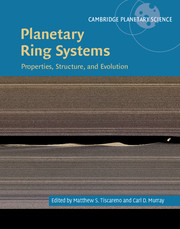Book contents
- Frontmatter
- Contents
- List of Contributors
- Acknowledgements
- I Introductory Material
- II Ring Systems by Location
- III Ring Systems by Type and Topic
- 8 Moonlets in Dense Planetary Rings
- 9 Meteoroid Bombardment and Ballistic Transport in Planetary Rings
- 10 Theory of Narrow Rings and Sharp Edges
- 11 Narrow Rings, Gaps, and Sharp Edges
- 12 Dusty Rings
- 13 The F Ring of Saturn
- 14 Plasma, Neutral Atmosphere, and Energetic Radiation Environments of Planetary Rings
- 15 Thermal Properties of Rings and Ring Particles
- 16 Computer Simulations of Planetary Rings
- 17 Laboratory Studies of Planetary Ring Systems
- 18 The Origin of Planetary Ring Systems
- IV Concluding Material
- Index
- Plate section
- References
9 - Meteoroid Bombardment and Ballistic Transport in Planetary Rings
from III - Ring Systems by Type and Topic
Published online by Cambridge University Press: 26 February 2018
- Frontmatter
- Contents
- List of Contributors
- Acknowledgements
- I Introductory Material
- II Ring Systems by Location
- III Ring Systems by Type and Topic
- 8 Moonlets in Dense Planetary Rings
- 9 Meteoroid Bombardment and Ballistic Transport in Planetary Rings
- 10 Theory of Narrow Rings and Sharp Edges
- 11 Narrow Rings, Gaps, and Sharp Edges
- 12 Dusty Rings
- 13 The F Ring of Saturn
- 14 Plasma, Neutral Atmosphere, and Energetic Radiation Environments of Planetary Rings
- 15 Thermal Properties of Rings and Ring Particles
- 16 Computer Simulations of Planetary Rings
- 17 Laboratory Studies of Planetary Ring Systems
- 18 The Origin of Planetary Ring Systems
- IV Concluding Material
- Index
- Plate section
- References
Summary
INTRODUCTION
Elaborating upon a suggestion by Bandermann and Wolstencroft (1969), Cook and Franklin (1970) estimated the net global loss or gain of mass due to material added to or ejected from Saturn's rings through hypervelocity impacts by interplanetary meteoroids. They concluded that the net changes could be large over billions of years if the principal impactors were dust particles from long-period comets, like Halley. In the course of their analysis, they described many key features of meteoroid bombardment of rings but focused mainly on the small fraction of impact ejecta that might reach large enough speeds to escape the rings. Tiny chips with large charge-to-mass ratios can also be lost to Saturn's atmosphere along magnetic field lines (Northrop and Connerney, 1987).
When the Pioneer and Voyager spacecraft revealed a plethora of ring structure on a variety of scales, several researchers shifted their attention to the vast bulk of impact ejecta, which are small solid chips without significant charge that move more slowly (Durisen, 1984b). These slower ejecta become launched on elliptical orbits out of the ring plane and may be reabsorbed at radii different from where they originated. Continuous exchange of impact ejecta between different ring regions can lead to net transport of mass and angular momentum and can cause mixing of composition differences in radially extended rings of moderate optical depth, like Saturn's main rings.
Ip (1983) dubbed this ejecta exchange process “ballistic transport” (BT), and Cuzzi and Estrada (1998) called the resultant composition mixing “pollution evolution” (PE). Early research (Ip, 1983; Morfill et al., 1983; Durisen, 1984a,b; Lissauer, 1984; Northrop and Connerney, 1987; Durisen et al., 1989) suggested that meteoroid bombardment could produce observable structure, especially in regions of pre-existing radial density contrast, on relatively short timescales. The theory has since been developed in detail, and Cassini results have renewed interest.
In this chapter, after discussing meteoroid influx rates and the nature of collisions between small meteoroids and ring particles, we will introduce the equations and input physics required to model BT and PE and describe applications to various real ring features that are probably associated with these processes. For Saturn, these include the ramps inward of the B and A ring edges, sharpening of these edges against viscous spreading, color/albedo differences between ring regions, the undulatory structure in the C and inner B rings, and possibly the C ring plateaus.
- Type
- Chapter
- Information
- Planetary Ring SystemsProperties, Structure, and Evolution, pp. 198 - 224Publisher: Cambridge University PressPrint publication year: 2018
References
- 3
- Cited by



